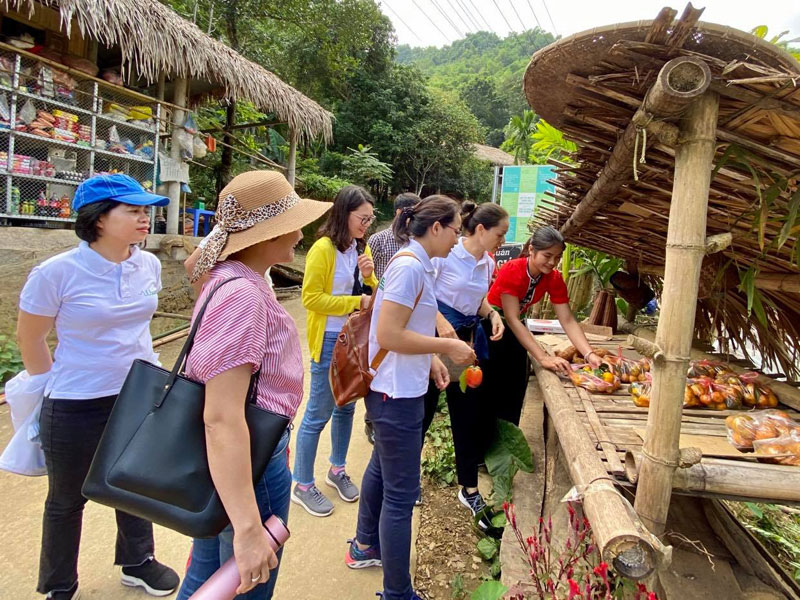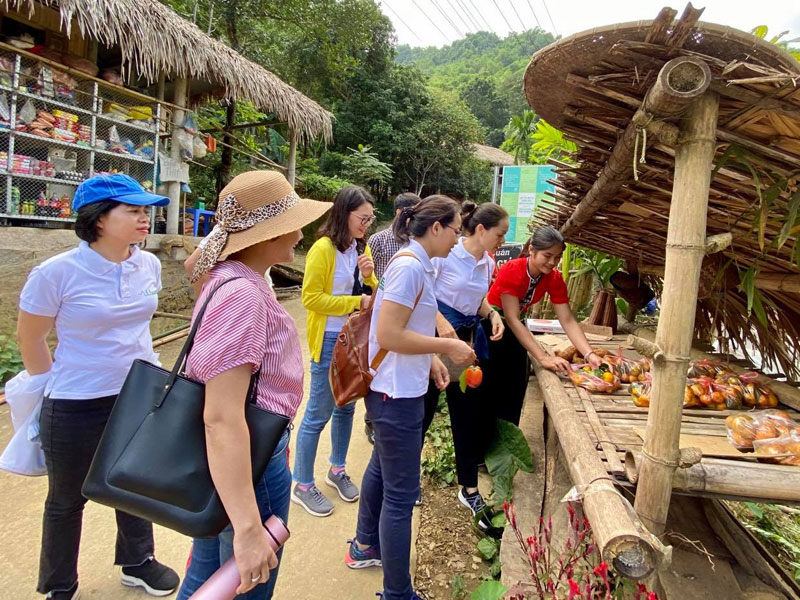


From 2015, with the support of the Australian Foundation for the People of Asia and the Pacific (AFAP), the villages here have transformed themselves, forming attractive tourism destinations. In the journey exploring tourism in Hoa Binh lake area, a lot of tourists, especially foreigners, have fully devoted their love to the people and this land.
 Tourists are
visiting and learning the model of "self-awareness shops” of Muong Ao Ta people
in Tien Phong commune (Da Bac).
Tourists are
visiting and learning the model of "self-awareness shops” of Muong Ao Ta people
in Tien Phong commune (Da Bac).
Located on the stretching and poetic banks of Da River, the community tourism village, Da Bia, (now it is Duc Phong village) is the home of more than 40 households, 100% of which are Muong Ao Ta people. According to Mr. Dinh Van Dai, the Secretary of Duc Phong hamlet, Muong Ao Ta community in the district is concentrated in two hamlets of Duc Phong and Muc of Tien Phong commune. Besides the landscape of the mountains, the rivers, the environment and the cool and fresh climate, Da Bia evokes the curiosity, attracting visitors by the unique culture of Muong Ao Ta ethnic people. Here, most of the people have preserved the stilt houses with the ancient architecture. Many beautiful customs and practices are still remained in the spoken language and everyday life.
Previously, Muong ethnic people in Da Bia mainly made their living by farming, fishing, and afforestation. Since approaching the tourism profession, 5 households have renovated their houses and participated in building the model of homestay accommodation to welcome visitors. More than 40 local people have participated in the activities of boat services, food teams, entertainment teams and so on. When coming here, visitors can experience the cultural space and the daily life of the indigenous people besides the feeling of conquering the nature. In addition, they can discover an interesting thing about the "self-awareness shops” - the form of purchase, sale and exchange like a supermarket of Muong ethnic people in Hoa Binh. They can enjoy the cuisine of Muong Ao Ta people, mainly taken from self-sufficient sources such as jogging chicken, free-range pigs, fish from Da River, steamed wild vegetables ... processed with its own taste, which are bold and strange to the mouth.
In Tien Phong commune, there is another Muong village called Mo Hem that has just started to develop community tourism. The village is the residence of more than 30 households, and they have been welcoming guests from 2019, which is the newest destination of the project of community tourism in Da Bac. When coming here, visitors can enjoy the fresh air of the lake area, stay at traditional community motels, walk around the village, learn the traditions of Muong people in the lake area, participate in fish catching, or cook the traditional dishes of the indigenous people, enjoy food, exchange performance shows and so on.
With the help of international organizations and the company of Da Bac community tourism, the commune has chosen a new direction to exploit the potentials and strengths of the natural landscape and the culture values of the native Muong ethnic people. In order to create a friendly environment, making good and unforgettable impressions for tourists, the villages and hamlets doing community tourism have well implemented the set cultural codes. These codes are as follows: Do not purchase or use the services from street vendors, do not buy and sell products from hunting or deforestation, respect the local customs and practices ... The good news is that more and more visitors are coming to the community villages of Mo Hap and Da Bia. Thereby, it has been contributing to improving the people's lives, at the same time it has been promoting and introducing the images of the nature, the people and the indigenous cultures to domestic and international friends.